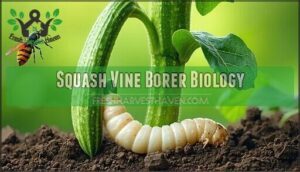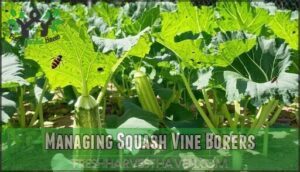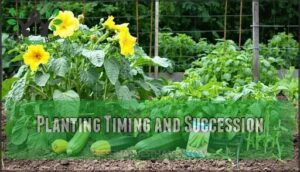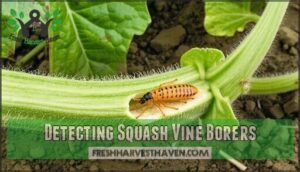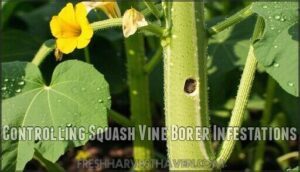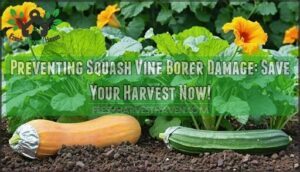This site is supported by our readers. We may earn a commission, at no cost to you, if you purchase through links.
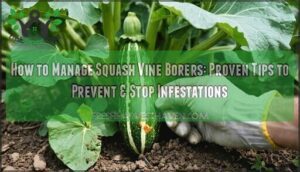
Start with row covers during egg-laying season in early summer, then watch for orange-and-black adult moths and the telltale sawdust-like frass around stem bases.
When you spot these warning signs, act fast—hand-remove eggs, apply beneficial nematodes, or carefully extract larvae from infected stems.
Combine prevention tactics like crop rotation and resistant varieties with active monitoring for maximum protection.
The secret isn’t just one magic bullet, but layering multiple strategies that work together seamlessly throughout the growing season, which is the key to success.
Table Of Contents
- Key Takeaways
- Squash Vine Borer Biology
- Managing Squash Vine Borers
- Prevention Strategies
- Detecting Squash Vine Borers
- Controlling Squash Vine Borer Infestations
- Frequently Asked Questions (FAQs)
- Do squash vine borers kill plants?
- How do I prevent squash vine borer?
- Do squash vine borers overwinter?
- How do borers affect a squash plant?
- How do you know if a squash vine borer is attacking your plants?
- Can squash vine borers destroy cucurbit stems?
- How do you get rid of squash vine borers?
- Can you save a plant from squash vine borers?
- Do coffee grounds repel squash vine borers?
- What is the best insecticide for squash borers?
- Conclusion
Key Takeaways
- Time your defenses with their lifecycle – Use row covers during early summer egg-laying season, then watch for orange-and-black moths and sawdust-like frass around stem bases to catch infestations early.
- Layer multiple prevention strategies – You’ll get better results by combining resistant varieties, like butternut squash, crop rotation, and physical barriers, rather than relying on just one method.
- Act fast when you spot warning signs – Hand-remove eggs immediately, extract larvae from infected stems with a knife, or apply beneficial nematodes before damage becomes irreversible.
- Focus on stem bases during peak season – Check weekly from mid-June through August for small brown eggs and entry holes, since larvae become nearly impossible to control once they’re inside stems.
Squash Vine Borer Biology
Understanding squash vine borer biology is your first step toward effective management since these clearwing moths follow a predictable lifecycle you can disrupt.
You’ll recognize the orange-and-black adult moths that resemble wasps, their tiny brown eggs laid at stem bases, and the telltale white larvae with brown heads that tunnel through your plants.
Life Cycle of Squash Vine Borers
Understanding the life cycle of squash vine borers gives you the upper hand in protecting your garden.
Know your enemy’s lifecycle to win the war against vine borers.
These Melittia cucurbitae moths complete their development through four distinct stages that spell trouble for your plants.
The Egg Stage begins when adults lay flat, brown eggs at stem bases in early summer.
Larval Development follows as cream-colored larvae with brown heads tunnel into stems, causing devastating damage.
Pupal Formation occurs when mature larvae exit plants and burrow into soil to transform.
Finally, Adult Emergence releases new moths ready to mate and restart the cycle.
Here’s what makes this cycle particularly challenging:
- Seasonal Migration patterns mean timing varies by region – northern areas see one generation yearly while southern climates often experience two
- Larvae spend weeks hidden inside stems, making detection difficult until damage becomes severe
- Pupae overwinter in soil, emerging as adults when temperatures warm in spring
Effective squash protection methods are vital to prevent significant damage to your squash plants.
Identification of Squash Vine Borers
Now that you know their lifecycle patterns, spotting Melittia cucurbitae becomes straightforward with the right Borer Signs.
Moth Identification starts with recognizing these wasp-like mimics—they’ve got orange-black bodies with metallic green wings and buzz around your squash plants during evening hours.
This clearwing moth activity peaks from mid-June through July, so watch for their distinctive flight patterns near your vines.
Larvae Detection means looking for cream-colored grubs with brown heads inside damaged stems.
These white maggots tunnel through your plant’s vascular system, creating the perfect storm for Stem Damage.
Egg Location requires checking stem bases and leaf joints for tiny, flat brown eggs—they’re about the size of a pinhead and easy to miss.
Early identification prevents larvae infestation from destroying your entire harvest.
Symptoms of Infestation
Three telltale signs reveal squash vine borers have invaded your garden. Wilted plants suddenly collapse despite adequate watering, signaling disrupted water flow.
Smart gardeners know that wilted plants with firm roots spell vine borer trouble.
You’ll spot these symptoms:
- Stem holes with orange or green frass (sawdust-like waste) around entry points
- Plant wilting and leaf yellowing during hot afternoons, recovering slightly by evening
- Plant collapse as larvae sever essential stem tissue, causing rapid deterioration
Managing Squash Vine Borers
Anyone can tackle squash vine borers with the right game plan. Success depends on combining multiple strategies rather than relying on one silver bullet.
Smart gardeners know that effective vine borer prevention requires layering tactics like a skilled chess player.
Borer Traps using yellow sticky cards help monitor adult moth activity. Garden Sanitation removes overwintering sites by destroying old plant debris each fall. Soil Health improvements through compost and proper drainage create resilient plants that better withstand attacks.
| Strategy | Timing | Effectiveness |
|---|---|---|
| Pest Monitoring | Weekly June-July | High detection rate |
| Crop Diversity | Spring planting | Reduces total damage |
| Borer Traps | Adult emergence | Monitors population |
| Soil Health | Year-round | Strengthens plants |
| Garden Sanitation | Fall cleanup | Breaks life cycle |
Understanding vine borer life cycles is essential for effective management. Natural pest management works best when you’re proactive. Squash plant care includes regular stem inspections for eggs and frass. Crop Diversity spreads risk—if borers hit your zucchini, resistant butternut varieties might survive. Borer control succeeds through persistence and timing, not quick fixes.
Prevention Strategies
The best defense against squash vine borers starts before they even arrive in your garden.
You’ll want to implement multiple prevention strategies early in the season, since these sneaky pests become nearly impossible to control once they’ve burrowed into your plants’ stems, and this is a critical step for a successful defense.
Row Covers and Barriers
Row covers act like protective shields for your squash plants against vine borers. Install floating row covers immediately after planting, securing edges tightly to prevent moth entry. These physical barriers eliminate egg-laying opportunities while maintaining plant health.
Using row covers is an effective method for preventing vine borer damage to your squash plants.
Effective barrier methods include:
- Floating Row covers anchored with landscape staples or rocks
- Stem Wrapping with aluminum foil around plant bases
- Row Cover removal during flowering for pollination access
- Physical Barriers like nylon stockings around vulnerable stems.
Remove covers daily for 1-4 hours during bloom time to guarantee proper pollination while maintaining vine borer prevention.
Resistant Varieties and Crop Rotation
Why struggle with squash vine borers when resistant varieties make the fight easier? Cucurbita moschata types like butternut squash boast tough stems that repel up to 90% of borer attacks.
Crop rotation breaks the pest cycle—moving squash beds annually reduces infestations by 70%. Resistant seeds including Tromboncino and Tatume offer proven protection.
Combine plant diversity through companion planting with strategic rotation schedules for maximum defense against these destructive pests.
Using resistant varieties can substantially reduce the risk of infestation and damage to squash plants.
Organic Control Methods
Beyond resistant varieties and crop rotation, organic control methods provide powerful backup strategies.
Bacillus thuringiensis injections target larvae before they tunnel deep into stems. Beneficial nematodes in soil attack overwintering pupae, while companion planting with herbs attracts parasitic wasps.
Organic sprays like neem oil deter egg-laying moths. Natural repellents such as diatomaceous earth around plant bases add protection.
Crop sanitation removes debris where pupae hide. Soil management through tilling exposes overwintering stages.
These biological controls create layered defense systems for effective organic pest control.
Planting Timing and Succession
Strategic timing can outsmart squash vine borers by avoiding their peak activity periods. Plant your summer squash after mid-July when adult moths have finished laying eggs, or start Early Planting in spring for harvest before midsummer emergence.
Succession Planning every 2-3 weeks maintains Crop Scheduling flexibility.
- Early spring planting beats borer emergence with harvest before peak season
- Mid-July delayed planting avoids adult moth egg-laying period completely
- Succession planting every 2-3 weeks provides backup crops and continuous harvest
- Crop rotation prevents soil-dwelling pupae from targeting new plantings nearby
Detecting Squash Vine Borers
Early detection is essential since squash vine borers cause irreversible damage once they tunnel inside plant stems.
You’ll need to watch for specific warning signs that indicate these destructive pests have targeted your squash plants.
The presence of these pests can be identified by looking for signs such as irreversible damage.
Visual Signs of Infestation
Spotting squash vine borers requires sharp eyes and daily garden checks.
Wilting Plants that droop despite moist soil signal trouble—these aren’t drought casualties.
Watch for Stem Holes about ⅛ inch wide where larvae entered.
Frass Signs appear as orange-yellow sawdust piles near borer holes.
Leaf Yellowing spreads from damaged stems as water flow stops.
Plant Collapse follows when larvae sever essential tissue.
Yellowing plants and sudden decline mean the damage is done—prevention beats cure every time.
Frass and Entry Holes
Two telltale signs reveal squash vine borers’ presence: distinctive frass and entry holes that spell trouble for your plants.
Frass identification becomes essential when you’re hunting for these destructive pests. Look for this sawdust-like material around stem bases:
- Orange-yellow, sticky frass resembling wet sawdust
- Small entry holes measuring ⅛ to ¼ inch diameter
- Fresh borer holes with surrounding stem damage
- Mushy, rotted areas indicating secondary infections
- Concentrated infestation signs at plant base level
Wilting and Plant Collapse
When you spot orange frass around Stem Damage, wilting follows quickly.
Squash vine borers disrupt water flow, causing Leaf Wilt during hot afternoons.
Your plant might recover temporarily, but sudden wilting signals serious vine borer damage.
Plant Decline accelerates as larvae sever vascular tissue, leading to plant collapse.
Water Loss becomes irreversible, and Root Rot from secondary infections often finishes what the borers started.
Monitoring for Adult Moths
Adult moths emerge mid-June through August, flying in distinctive zigzag patterns near vine bases.
Pheromone traps help with Adult Monitoring and Moth Identification – look for orange-bodied moths with metallic wings.
Yellow attraction makes sticky traps effective for tracking moth activity.
Monitor Flight Patterns daily during early morning hours when adult moths are most active for effective Egg Detection.
Understanding the squash vine borer life cycle is vital for effective prevention and control methods.
Controlling Squash Vine Borer Infestations
When you’ve spotted the telltale signs of squash vine borer damage, quick action can save your plants and salvage your harvest.
You’ll need to act fast since these destructive larvae work around the clock to hollow out your squash stems from the inside.
Hand Removal of Eggs and Larvae
Manual Control offers your best defense against these sneaky pests. When you spot those telltale signs, immediate handpicking prevents egg hatching and stops the larval stage before stem entry occurs.
Here’s your systematic approach:
- Egg Inspection – Check stem bases weekly for small, brown, flat eggs
- Larva Removal – Slice open affected stems carefully with clean knife
- Stem Slicing – Cut lengthwise along entry holes to expose borers
- Borer Extraction – Remove white larvae with tweezers or fingers
- Handpicking Borers – Destroy all extracted larvae immediately to prevent re-infestation
Understanding squash vine borer life cycles is essential for effective prevention and control.
Insecticidal Soap and Diatomaceous Earth
Beyond hand removal, insecticidal soap and diatomaceous earth provide effective organic methods for squash vine borer control. These natural insecticides work best as preventative measures.
| Method | Application | Effectiveness |
|---|---|---|
| Soap Application | Weekly stem base spraying | High on eggs, low on larvae |
| Earth Benefits | Dry powder around plants | Desiccates soft-bodied pests |
Insecticidal soap smothers eggs through direct contact, requiring thorough coverage of lower stems. Diatomaceous earth kills through desiccation but loses effectiveness when wet.
Both pest control methods need repeated treatments during peak egg-laying periods for best soil treatment results. For effective squash vine borer management, understanding insecticidal soap properties is key.
Natural Repellents and Deterrents
Nature’s arsenal offers powerful weapons against squash vine borers.
These natural repellents create hostile environments for egg-laying moths while protecting your harvest:
- Companion planting with nasturtiums and mint confuses moths with competing scents
- Repellent herbs like dill and fennel attract beneficial wasps that prey on borers
- Natural barriers using diatomaceous earth around stem bases deter adult moths
- Soil amendments strengthen plants’ natural defenses against pest invasion
Neem oil applications and row covers provide additional organic protection layers.
Chemical Control Methods
When natural deterrents fall short, chemical sprays become your next line of defense. Success depends on perfect timing—you’ll need to apply insecticides right when eggs hatch, before larvae tunnel into stems.
Pyrethroid insecticides like bifenthrin and permethrin deliver excellent results, while spinosad offers effective organic control. Acetamiprid works as a systemic option for soil treatment.
Here’s your battle plan:
- Choose proven pesticides: Bifenthrin, permethrin, or spinosad target newly hatched larvae effectively
- Time applications precisely: Apply when frass appears or moths are active in early summer
- Target stem bases: Focus chemical sprays where larvae enter, avoiding flowers during pollinator activity
Frequently Asked Questions (FAQs)
Do squash vine borers kill plants?
Yes, squash vine borers can kill your plants by tunneling through stems and severing the vascular system.
The larvae disrupt water and nutrient flow, causing sudden wilting and eventual plant collapse if left untreated, which is a complete consequence of their action.
How do I prevent squash vine borer?
Use floating row covers during moth flight season, plant resistant varieties like butternut squash, apply crop rotation, and wrap stem bases with aluminum foil to block egg-laying.
Do squash vine borers overwinter?
Like autumn leaves settling into winter’s grip, squash vine borers hibernate as pupae in the soil beneath your garden.
These sneaky pests burrow 1-6 inches deep, waiting for spring’s warm embrace to emerge as adult moths ready to wreak havoc again, particularly as they relate to the garden.
How do borers affect a squash plant?
Squash vine borers tunnel inside your plant’s stems, disrupting water and nutrient flow, which causes sudden wilting and yellowing leaves despite adequate soil moisture, ultimately leading to plant collapse.
How do you know if a squash vine borer is attacking your plants?
Look for sudden wilting despite moist soil, orange-yellow frass (sawdust-like material) at stem bases, and small holes in stems.
These telltale signs indicate larvae are tunneling inside, disrupting water flow and slowly killing your plants.
Can squash vine borers destroy cucurbit stems?
Devastating damage develops when these determined destroyers drill deep into your plant’s vascular system.
Yes, squash vine borer larvae can completely destroy cucurbit stems by tunneling through and severing the water-conducting tissue, causing sudden wilting and plant collapse, which results from the larvae’s ability to completely destroy the plant’s internal structures.
How do you get rid of squash vine borers?
Remove borers by slicing open infested stems with a knife to extract white larvae manually. Apply preventive measures like row covers, crop rotation, and planting resistant varieties for future protection.
Can you save a plant from squash vine borers?
When the horse is out of the barn, swift action can still save it.
You can rescue infected plants by slicing open stems and removing white larvae by hand, then covering wounds with soil to encourage new root growth.
Do coffee grounds repel squash vine borers?
Coffee grounds haven’t proven effective against squash vine borers in research studies.
While some gardeners swear by them, there’s no scientific evidence that coffee grounds repel these moths or prevent egg-laying on your squash plants.
What is the best insecticide for squash borers?
Like battling an invisible enemy, you’ll find Bacillus thuringiensis (BT) your strongest ally.
Apply BT thuricide to stem bases as prevention, since larvae inside stems resist most treatments once they’ve burrowed in.
Conclusion
Research shows that squash vine borers can destroy up to 90% of unprotected squash crops in a single season.
Successfully learning how to manage squash vine borers requires consistent vigilance and multiple defense strategies working together.
You’ll achieve the best results by combining preventive measures like row covers with active monitoring for adult moths and telltale frass.
Remember that timing is everything—early detection and immediate action make the difference between a thriving harvest and devastating crop loss.
Stay persistent, and your squash plants will reward you.
- https://extension.umn.edu/yard-and-garden-insects/squash-vine-borers
- https://www.themeateater.com/wild-and-whole/gardening/how-to-get-rid-of-squash-vine-borers-without-pesticides
- https://www.canr.msu.edu/news/squash_vine_borer_biology_and_management
- https://academic.oup.com/jipm/article/9/1/22/5061838
- https://www.growjourney.com/prevent-stop-squash-vine-borers/

